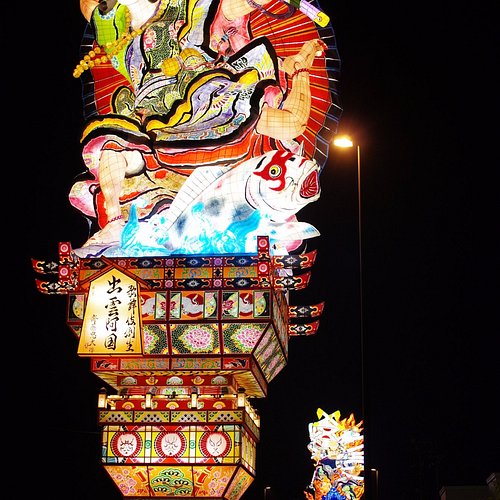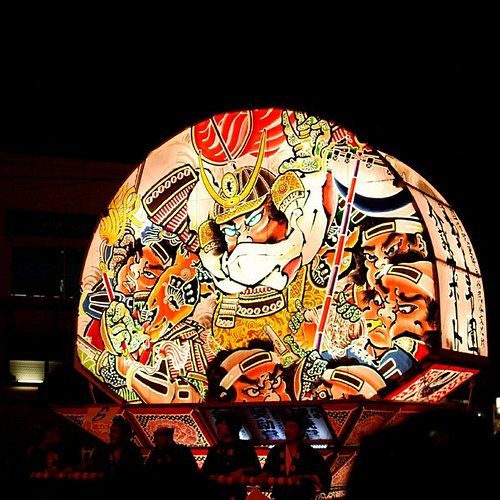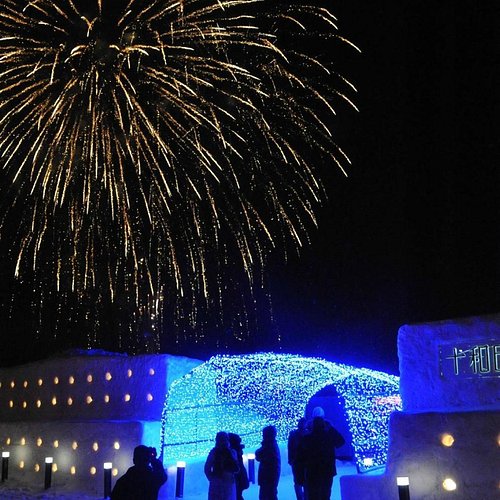Top 9 Events in Aomori Prefecture, Tohoku
Aomori Prefecture (青森県, Aomori-ken) is a prefecture of Japan located in the Tōhoku region. The capital is the city of Aomori.
Restaurants in Aomori Prefecture
1. Aomori Nebuta Festival
Overall Ratings
4.5 based on 104 reviews
The Nebuta Summer Festival (or Matsuri) that takes place in early August every year in Aomori is quite simply one of the most unforgettable and unique street parades in the world. Local teams work each year to build 24 huge floats using wire frames covered with washi paper that sometimes represent Japanese gods and mythical creatures, but also historical figures and the contemporary actors that play them in Kabuki theatres and on Japanese TV. These intricately crafted sculptures are then lit from the inside with thousands of colourful lights and paraded each night around a 3km loop in the town of Aomori. Thousands of people take a part in carrying the floats, parading with taiko drums, flutes and cymbals, and dancing in traditional costumes chanting Rassera! Rassera! It's breathtaking to watch the vivid, colourful floats weaving at night through the throngs of musicians and dancers and you can find your own spot or reserve seating to enjoy it all. But that's not all. Anyone, regardless of age or ability, is invited to join in as long as they are wearing the traditional haneto dancing costume (which can be rented for about $30 from shops all over Aomori). Unforgettable!
2. Goshogawara Tachineputa Matsuri
Overall Ratings
4.5 based on 50 reviews
The Taichineputa no Yakata festival, held in Goshogawara every August, features vast 'taichineputa': glowing parade floats nearly 80 feet tall and weighing in at about 38,000 pounds! People help to shoulder the floats throughout the city, while dancers and musicians energize onlookers with chants and riffs. It's a high-energy and visually stunning parade, with about fifteen floats in total-- three of which are larger than life.
3. Hachinohe Sansha Taisai
Overall Ratings
4.5 based on 33 reviews
The summer festival of Hachinohe Sansha Taisai is historic to is prefecture, having been celebrated for over two-hundred years. The festival is characterized by a parade of large, intricate floats with images from myth and history. These floats are unique, in that along with being massive constructions, they are also mechanized: with floating dolls, moving parts, and even valves that release smoke. Over 25 floats are accompanied by dancers performing traditional renditions of the lion, tiger, and bamboo leaf dances, along with flute and drum music. The festival takes place July 31st-August 4th.
4. Hirosaki Neputa Matsuri
Overall Ratings
4.5 based on 53 reviews
Presented on August 1st-7th, the Hirosaki Neputa festival brings Japanese folk-culture to life. Massive floats are painted with scenes from the country's mythologies and history in a traditional style, then illuminated from the inside so that they glow a brilliant yellow-orange. The floats are then paraded through the city are night, to the sound of taiko drum beats and fluttering notes on the flute. Some areas of the city also dedicate themselves the to past during this time, with tea houses opening their doors and shamisen music on the air.
5. Hirosaki Cherry Blossom Festival
Overall Ratings
4.5 based on 171 reviews
A spring festival at Hirosaki Park, famous for its cherry blossoms and boasting 2,600 cherry trees in about 50 varieties, such as Weeping Cherry and Double-Flowered Cherry. Held every year between April 23rd and May 5th, it delights the eyes of tourists with its cherry tree tunnel and western moat dyed the color of cherry blossoms. The cherry trees illuminated at night seem to float magically and make for a different charm than in the daytime. Don't miss the flowering of such invaluable trees as Japan's oldest Yoshino cherry (planted in 1882) and largest circumference Yoshino cherry (a little over 5m).
6. Lake Towada Winter Story
Overall Ratings
4.0 based on 17 reviews
Reviewed By Dandelious - Hong Kong, China
This is the first snow festival I've ever joined, and the Towadako Winter Tale is amazing!! I love the way they put lights in the snow, making some sort of snow lanterns along the roads. This is quite romantic. I had lots of fun sliding down a snow-made slope (a sled has to be rented for 300 Yen for 30 mins). I love the cafe which offers drinks in ice glass. At 8 PM, they had fireworks, which are bsolutely stunning! It might be a bit hard to access, tho, when most public transports are not available in winter in the Oraise and Lake Towada area. I booked a hotel near the venue, and this hotel happened to have a free shuttle service from Hachinohe Station, which is easily accessible by JR Trains. Otherwise, one might have to get on one of the buses/tours that run from the Towada city centre. Though it might not be easy to access, it is worthwhile to try to come and join the festival!
7. Hachinohe Embri
Overall Ratings
3.5 based on 10 reviews
The Hachinohe Embri features the distinctive folk arts of the Hachinohe region and has been designated one of Japan's Important Intangible Folk Cultural Properties. It is also counted as one of Aoyama Prefecture's three largest festivals and one of the five Michinoku Snow Festivals. Dancers known as "tayu" who wear giant eboshi hats mimic the actions of rice cultivation, such as sowing seeds and planting seedlings, and dance to pray for a bountiful harvest. In the interim, attendees can also enjoy the "shukufukugei" blessing dances performed by young children.
8. Tohokumachi Kosui Festival
Overall Ratings
3.5 based on 4 reviews
This festival is held the fourth weekend in July in the main event venue of the town of Tohoku in Kamikita, Aomori. It hosts a wide variety of events that the whole family, kids & adults alike, can enjoy, such as a huge treasure hunt, homemade raft races, "beach flags" beach sprinting races, freshwater clam harvesting, a marathon, and more. The first night features a huge fireworks show, with about 2,800 fireworks and displays from famous pyrotechnicians and fireworks companies that light up the lake's surface with color. Both days of the festival feature numerous gift shops and street stalls.
9. Lake Towada Kosui Matsuri
Overall Ratings
4.0 based on 8 reviews







